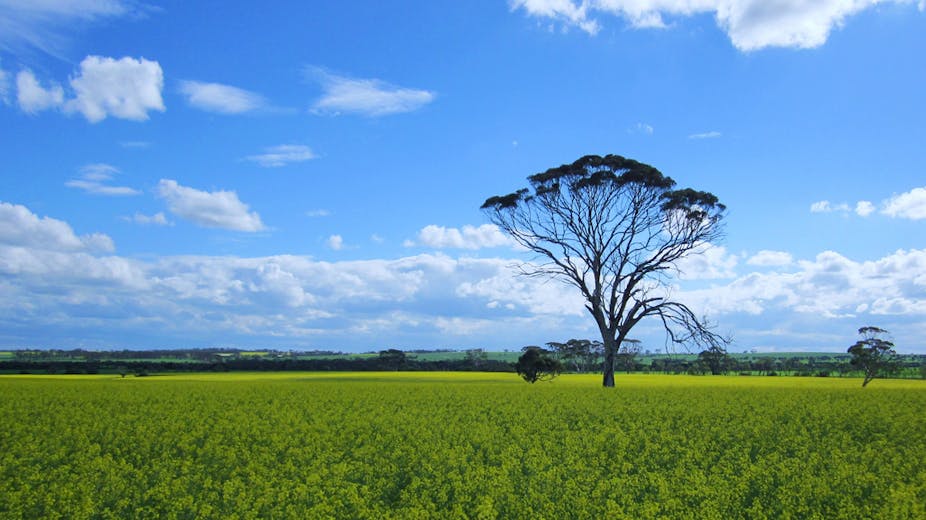Biodiversity and farming go head to head in two R&D projects that I have a hand in. The struggles to both feed the swelling ranks of humanity and save our continent’s natural splendour are so often at odds, but we need to find a way to marry the two. The projects I’m involved in are:
1) a bid for a Cooperative Research Centre (CRC) for Safeguarding Biodiversity (twitter #safeguardingbiodiversity), a national program designed to prevent the extinction of Australian native vertebrate animals
2) UWA Future Farm 2050, for which the vision is “Imagine the ideal farming system for 2050, and do it now” (the year 2050 has been chosen because, by then, we will need to feed 50% more people globally without destroying the planet).
These two projects collide head-on because biodiversity can be lost when we change the landscape, and the farmers of Australia are the custodians for as much as 80% of the landscape. We cannot do without agriculture, but the industry must be profitable. By contrast, protecting biodiversity is unlikely to be profit-driven. Can the two ventures be compatible? One aspect of the UWA Future Farm project aims to show that they can be.

The Future Farm project might look like academic idealism but, in fact, its major indicator of success will be a normal level of profitability. The crop (wheat, canola) and animal (primarily sheep) enterprises will fit the 2050 vision but they must be profitable so the farm can pay salaries and have money for maintenance and development.
However, about 35% of the 1600 hectares is not profitable for cropping or pastures because it is rocky or otherwise unsuitable. Arguably, this land should never have been cleared of native bush. This situation is typical of farms in the WA wheat/sheep zone, and probably typical for much of the Australian agricultural landscape.

This land, however, is not a waste but an opportunity. In the Future Farm project, we are re-establishing the native ecosystem on the non-profitable parts of the farm. This is no simple matter – one does not simply go out and plant a few favourite native bushes. We need professional expertise: people who can measure the local ecosystem, make informed estimates of its likely structure before colonisation, and then formulate a feasible mix of plants for restoration.
We began by planting 14,000 plants comprising a mix of native tree and shrub species belonging to functional groups that differ in the way they acquire nutrients. The planted area links two remnants of native bush and it is our first step towards the creation of a mosaic and corridors that we hope will include neighbouring farms and public roadside verges and nature reserves.
Clearly, we have high expectations that restored ecosystems will be colonised by other Australian plants and, of course, by native Australian animals. This brings us back to the bid for a CRC for Safeguarding Biodiversity and its three elements of research and development: i) gauge the urgency with which we need to tackle a given problem; ii) provide proven responses that solve the problem; and iii) future-proofing to prevent the problem recurring.
Part of CRC’s remit will be restoring and managing ecosystems restoration and management. We also have to grapple with the socio-political issues that get in the way of saving biodiversity. This type of problem is seen, for example, in cockatoos that are endangered yet are seen as pests by horticulturalists. At the other extreme, over-abundant animals are difficult to control in peri-urban areas.
Both the CRC and the Future Farm grapple with core elements of Australia’s self-image. We cannot imagine an Australia without our iconic animals such as the bilby or the black cockatoo, and we cannot imagine an Australia that does not produce food.

So what is needed to marry these two identities? Probably the highest priority will be creating a socio-political system that encourages the custodians of our landscape to both produce food and participate in safeguarding biodiversity. The policies and laws of the land need to be compatible rather than contradictory. We currently punish industries that cause environmental damage but we should also financially reward them if they invest in ecosystem restoration.
On the Future Farm, we are certain that ecosystem restoration will have little effect on our long-term profitability because we are only using non-profitable parts of the farm. But the initial cost is significant, certainly tens of thousands of dollars, and it would be unwise to expect all farmers to do this simply out of the goodness of their hearts. On the other hand, it seems feasible to ensure a commitment from the farmers if they were rewarded financially for their efforts – via carbon sequestration, for example.
Importantly, neither the CRC nor the Future Farm deal with a critical issue in modern Australia: the role of indigenous people, their history, their culture, and their relationship with the landscapes that we share.
It is critical that all Australians see farmers as part of the solution, not the problem.

